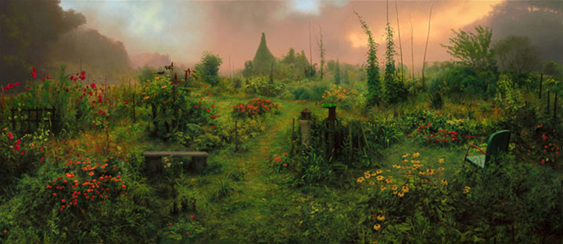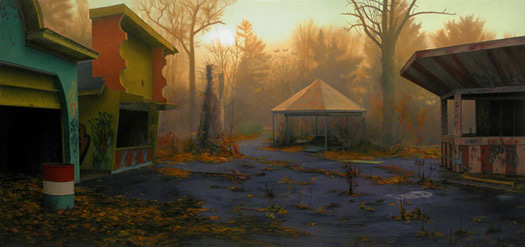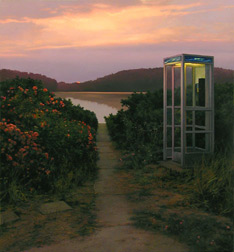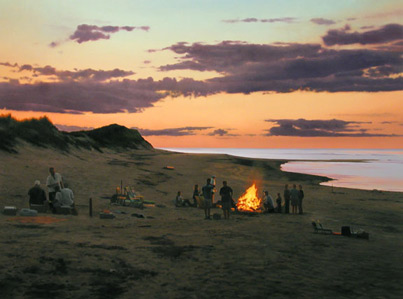Sometimes it is difficult for me to switch gears, to stop painting in order to reflect on what I am doing and try to explain myself. About landscape painting, I wrote this several years ago:
I believe that the underlying subject of all landscape painting is the conflict between Nature and Man, which is sometimes great and cataclysmic–as between the ocean and a waterfront condo, or an atom bomb and the Earth–but also sometimes small and subtle, as between garden clippers and a weed. Since childhood I have enjoyed discovering locations where it seems to me that nature and man are on equal footing. To me, the chance encounter of an abandoned tree house or a piece of rusted machinery in the woods is deliciously humorous and satisfying. I am also reminded of the mortality of things and the passage of time. It occurs to me that the battle between Nature and Man may not be already won. Mankind’s advances appear vulnerable, some grass has broken the concrete, and Nature, not boasting, has impressed me with its humility and strength.
I still basically agree with these philosophical statements although now I see the word “conflict” as too strong. Perhaps “interaction” would be better. In any event, all of my landscapes deal with humankind’s effects on nature. Usually I see this interaction as being ironic, sometimes humorous, but always complementary. I believe that there is beauty in the creation of Nature and Man working together. The tableau best epitomized by these ideas is the garden, where the gardener toils to utilize the raw material of Nature to create art (a human invention) while Nature effortlessly and continuously reclaims itself. This is happening in the painting “Mountain Park” where Nature is quickly devouring a human funhouse.
Another motif I utilize is the pathway, remnants of human footprints, wrestled from nature, appearing vulnerable but clinging to existence. In the paintings we usually don’t know where the path is taking us but I like to think that it is leading us to spiritual understanding, through nature.
Two paintings that perhaps deal with the ironic nature of my subject are “Phone Booth near the Lake” and “Fire on the Beach”. In the first, the phone booth is a distraction, a machine that invites us to connect immediately to anyplace in the world, anyplace but the here and now and the natural beauty of the lake and its sunrise. The irony in “Fire on the Beach” is that the party of revelers, instead of dropping to their knees to praise the sunset and ocean are probably discussing baseball and beer.
In discussing my philosophy of landscape painting, I am probably missing a more direct and immediate aspect of my paintings: the beauty and poignancy of the transitory nature of things and the passage of time. I believe that my interest in light and its effects helps depict this. My landscape subjects are usually specific moments in time (twilight, fog, etc.) and are more emotional and poignant because we are aware that they will be gone in a moment.
Scott Prior, 2004



